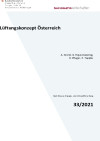Suchergebnisse
Lüftungskonzept Österreich

Ziel des Projektes ist die Schaffung eines Nachweisverfahrens (auf Basis Microsoft-Excel), welches zeigt, ob eine natürliche Lüftung bzw. Fensterlüftung bei einer Standardnutzung zur Vermeidung von Schimmelbildung ausreichend, bzw. in Hinblick auf eine ausreichende hygienische Luftqualität zumutbar ist.
Schriftenreihe
33/2021
A. Greml, G. Rojas-Kopeinig, R. Pfluger, P. Tappler
Herausgeber: BMK
Deutsch, 87 Seiten
Downloads zur Publikation
Technical status of ventilation systems for buildings

Evaluation of existing ventilation systems in Austria considering technical quality and practicability.
SQUARE - Qualitätssicherung in der Gebäudesanierung
Entwicklung eines systematischen, flexiblen Qualitätsmanagements für Sanierungsprozesse. Es soll zu qualitativ hochwertigen Sanierungen führen, die sich in verbesserter Energieeffizienz und einem verbesserten Wohnraumklima von Wohngebäuden zeigen.
Sunny Energy Building: ENERGYbase - Office building of tomorrow
Energybase is a showcase project in terms of energy efficiency and use of renewable energies realized by the Vienna business agency. With 7.500 sqm net floor area ENERGYbase provides space for innovative business and research and development on the field of green energy.
Mechanische Fensterlüftungsanlagen für die Althaussanierung
Analyse und Implementierungsmöglichkeit von alternativen Fensterlüftungsanlagen mit Fokus auf thermische Sanierung von Altbauten. Im Rahmen einer Technologierunde wurden die recherchierten und aufbereiteten Lüftungssysteme eine Gruppe Experten präsentiert. Zielsetzung war es, die Lüftungstechnologien anhand verschiedenster Aspekte zu diskutieren und zu jedem System eine SWOT-Analyse zu erarbeiten.
Betriebskosten- und Wartungskostenvergleich zwischen Passivhäusern und Niedrigenergiehäusern
Was spart ein Passivhaus im Betrieb tatsächlich? Rechnet sich ein Passivhaus? Wie sind z.B. Wartungskosten zu bewerten? Erstmals wurden systematisch die jährlichen Mehr- und Minderbetriebskosten von Passivhäusern erhoben und gegenübergestellt.
Rebuilding of the organic farm Achleitner, straw & clay - room climatisation with plants

Rebuilding of a marketing-, store- and processingcenter with an organic freshmart and an organic restaurant in passivhouse quality. Application of regional building materials, an innovatve overall energyconcept, climatisation with plants.
MPC boxes - Model Predictive Control von aktiven Bauteilen und Messungen in zwei Test-Boxen
Es wurde eine robuste, standardisierbare, prädiktive Regelung mit Wettervorhersagedaten für thermische Bauteilaktivierung entworfen, untersucht und ökonomisch bewertet sowie mit herkömmlichen Regelungen, insbesondere für Kühlzwecke, verglichen. Simulationen und Messungen an zwei für diesen Zweck geplanten und aufgebauten Test-Boxen dienten zur Analyse von Energieeffizienz und Komfort.
Erste Altbausanierung auf Passivhausstandard mit Vakuum-Isolations-Paneelen (VIPs)
Demonstration der Sanierungsmöglichkeit eines Bauwerkes des 19 Jhd. auf Passivhausstandard unter Berücksichtigung von hygrischen Vorgängen sowie in der Demonstration des Einsatzes von Vakuumdämmung.
EXPO HdZ: Best of Verbreitung von Ergebnissen der Programmlinie Haus der Zukunft

Konzeption und Umsetzung von Maßnahmen zur Verbreitung von ausgewählten Ergebnissen aus der Programmlinie Haus der Zukunft für die Bauwirtschaft, insbesondere für die Zielgruppen ArchitektInnen, Bauträger und HaustechnikerInnen.
Reduction of maintenance costs of ventilation systems in plus energy buildings
Maintenance costs for central air ventilation systems are approximately 0,42 Euro/m².a excluding VAT, for decentralized systems 1,16 Euro/m².a excluding VAT. 50% savings in operating costs of apartment passive houses opposed to apartment low-energy buildings [SCH11] can be achieved with maintenance costs of around 0,42 Euro/m².a.
Mechanical ventilation system for windows for the renovation of old buildings
Analysis and implementation of alternative ventilation systems for windows, focusing on thermal renovation of old buildings. The investigated ventilation systems were presented to an expert group. The aim was to discuss ventilation technologies with the help of different aspects and to develop a SWOT analysis.
Operational and maintenance costs in passive houses and low energy houses
How much energy does a passive house actually save? Does a passive house pay-off by itself? What are the costs for maintancence? For the first time an approximation for the running costs of a passive house were systematically documented and compared.
Reduktion der Wartungskosten von Lüftungsanlagen in Plus-Energiehäusern
Die Wartungskosten einer Lüftungsanlage sind ein wichtiger Bestandteil der Betriebskosten eines Plus-Energiegebäudes. In diesem Projekt werden die Wartungskosten von Lüftungsanlagen in gebauten Passivhäusern gegenübergestellt.
Auswirkungen des Klimawandels auf den thermischen Komfort in Bürogebäuden
Untersuchung der Auswirkungen des Klimawandels auf den thermischen Komfort am Beispiel mehrerer Bürogebäude in Wien mit Augenmerk auf das NutzerInnenverhalten. Dadurch wurden Grundlagen für die Erarbeitung detaillierter Anpassungsstrategien durch Immobilienwirtschaft und Politik geschaffen, die in Start- und Ergebnisworkshops aktiv in das Projekt einbezogen wurden.
Comfort and cost optimised air guiding concept for energy efficient housing
Ventilation systems for dwellings can be more efficient in terms of cost and energy, if the air guiding concept with cascade principle (overflow of air from sleeping rooms into living room). In this project, the planning principles had been developed and published in practice guidelines.
Sunny research! Nachhaltiges Gebäude- und Energiekonzept für ein modernes Büro- und Gewerbegebäude

Arsenal research plant für seine Forschungs- und Prüfdienstleistungen einen neuen Standort mit Büros, Labors, Werkstätten und Hallen, welcher hinsichtlich Energieeffizienz und Solartechnik optimiert werden soll.
Gründerzeit with future - demonstration project 2: ROOFJET Wißgrillgasse - sustainable solution for improving the thermal-energetic performance of a typical historical building in Vienna
The main aim of the project ROOFJET Wißgrillgasse is a building refurbishment by a factor of 8 which demonstrates that even historical buildings can be refurbished to lowest energy standard.This demonstration project shows a holistic and sustainable refurbishment concept for a special type of buildings with innovative technical and organizational solutions.
Comfort ventilation plus+: First time development of high efficient comfort ventilation systems that enable demand-control of room-wise airflow for new buildings and refurbishment
First time development of innovative components for comfort ventilation systems used in new buildings and renovation that enable demand-control of air flow room-wise. The outcome is a considerable reduction of the primary energy balance and a sustainable solution of problems concerning the discrepance between satisfying humidity and very good indoor air quality within the heating period.
SQUARE - A System for Quality Assurance when Retrofitting Existing Buildings to Energy Efficient Buildings
The project aims to promote a flexible quality assurance management for the retrofitting process. It leads to high quality renovations of residential multifamily buildings regarding energy improvement and improvement of indoor environment.
